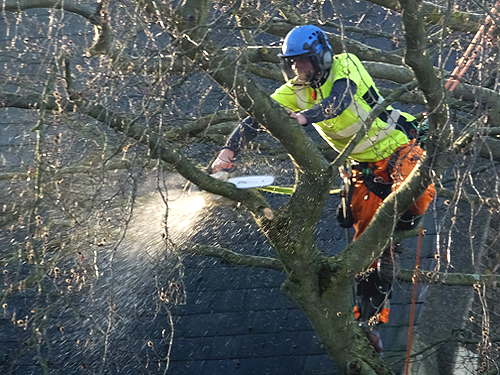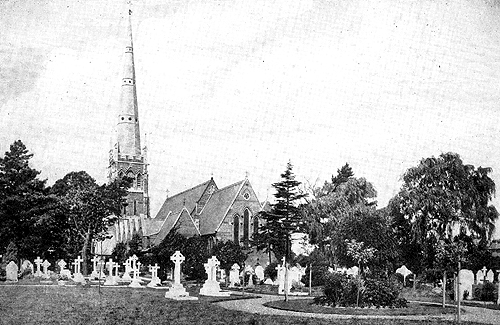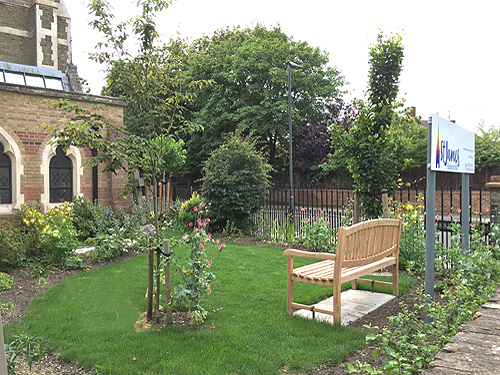
Originally the churchyard was just the area immediately surrounding the church. However, because of the growing population of the new parish, this was found to be too small. In 1882 the vicar of Hampton gave an acre of land next to the church in Park Road to be used as the parish burial ground. The churchyard now covers an area of approximately 1.6 acres and contains about 1200 known graves. The lych gate formerly stood nearer St James's Road but was moved to its present site in the early 1900s. Read how the lych was renovated in 2006 Lych Gate Renovation.
The churchyard contains many significant trees. Of the five English oaks found here, the dominant one, to the immediate south of the War Memorial, is estimated at 312 years old. The main Copper Beech, in the north-east section, has a girth of 3.8 metres and is estimated at 223 years old. There are many mature non-native trees as well as native ones.
The Churchyard through the years shows what happened from when records began up until 2017.
Churchyard History from 2017
An environmental initiative was launched at St James's Church in 2017. Eco-Church encouraged us to think about areas of church life where ‘green living’ can be improved. Together with the contractors who maintained the churchyard and Richmond Council’s ecology officer we worked to enrich the area for wildlife among other things. Then in 2021 the church was awarded the Bronze Eco Church Award in recognition of the work that was done and a few years later the Silver Award.
There were various Diocese of London’s conservation initiatives around this time, some under the banner of 'Caring for God’s Acre', a charity which promotes and assists in the care of churchyard green spaces. St James Church took part in these and made various steps to become pro-active in the management of the churchyard by working together with the London Borough of Richmond and Wandsworth Council to manage, protect and develop its wildlife flora and fauna. In September 2021, as part of the national Big Green Week, a community open day was held to encourage appreciation of the churchyard and challenged visitors to think about their carbon footprint.
St James's churchyard is an open space and freely accessible. The London Borough of Richmond recognises it as a Site of Interest for Nature Conservation (SINC). It is managed by St James's Church, in collaboration with the borough, for biodiversity. In June, as part of the national Churches Count on Nature week, people were encouraged to spend time in the churchyard to ‘spot’ wildlife. As well as church members and the public, spotters included Scouts, Brownies, Hampton Hill Nursery and Hampton Hill Juniors. Some 94 different species were identified and logged with the national database. Have a look at the results of the churchyard survey made in 2022.
The PCC agreed to match donations for a new covered cycle shelter which was installed in 2022. Then the following year in June the Great Big Green Saturday was held. Different events were held, including a walking tour of the churchyard introducing the wildlife. A new development in 2025 was the hosting of the first Hampton Hill Climate Chat at the end of April, which was attended by many people from the community.
The borough council approved plans to replace the two notice boards on Park Road and St James’s Road funded by a legacy left to St James’s.
The Annual Parochial Church Meeting Reports show the annual reports from the Properties Team, among others, since then (scroll down the document of the year you are interested in to find the report you want).
Graves History
The churchyard contains about 1200 known graves, many of which have damaged monuments, and 4,000 bodies, as several of the family graves contain more than one interment.
The first burial was that of Walter Richard Daines, aged 11 months in l864 and the very last burial was Bruna (Walter) Blaschke in 1987. Many fascinating people are buried in the churchyard, including Canadian Joe Boyle, whose remains were exhumed and returned to Canada in 1983, 60 years after his death; three stationmasters from Fulwell Station; John Templeton, the opera singer; and many more. Find out about the Graves in the Churchyard.
The War Memorial, listed Grade 2 in 2015, was erected in 1920. Near the war memorial there are 12 Canadian War Graves in a formal row, needed when the Canadian Military Hospital was situated in Bushy Park during the 1914-1918 war, and also 14 scattered War Graves. In addition, four graves within private memorials have also been identified. The Commonwealth War Graves Commission (CWGC) has established an initiative to provide care for the ‘Scattered War Graves’ throughout the UK. A CWGC sign, notifying that the churchyard contains war graves has been fixed to the iron railings at the south porch entranceway to the church. A new gravestone for someone who died on active service or as a result of their woundswas added to the churchyard in 2016. Provided by the CWGC, all these graves are marked by small white stones that include details of the regiment that person served in.
In 1991 the churchyard was closed by an Order in Council made by the Privy Council and handed over to the London Borough of Richmond upon Thames to maintain. Only burials in existing spaces and the interment of ashes now take place. Ashes are interred in the Garden of Rest (sometimes called Garden of Remembrance), an area of grass and rose bushes near the lychgate, and occasionally in graves. On request, names are recorded in a Book of Remembrance inside the church.
Graves History from 2017
In 2018 the church was approached by Roland Bostock from the West Middlesex Family History Society, which was aiming to record the details of every grave in the former county boundary. Roland, and his assistant, Yvonne, took photos of every grave as well as recording all the inscriptions. St James’s was the first church to have photos of all the gravestones attached to the online records. See the documents Memorials & Graves Introduction and Memorials & Graves both written by Roland Bostock.
The Annual Parochial Church Meeting Reports show the annual reports from the Properties Team, among others, since then. (Scroll down the document of the year you are interested in to find the report you want)
Churchyard Records History
The original churchyard records were on a huge roll of linen inscribed with each individual grave with a name in each box. In the early 1990s, after clearing the undergrowth, a working party set about recording the names and positions of all the graves in the churchyard. The first plan of the churchyard was drawn up in the 1960s when there were appointed Guardians of the Churchyard. Around 1990 a working party correlated the information in the five Burial Registers with the actual graves with numbers. Plans were drawn and a numbering scheme was used to make it easier to locate the graves.
All this information was collated into a booklet 'Churchyard Records 1864-2000', published in February 2001, containing complete listings of all burials and interments since the foundation of the church. Some years later it was updated and a list of interments of ashes from 2000-2014 was included. The booklet not only listed all the graves, but included plans of each area of the churchyard with the numbers of the graves.
An online searchable database for the Churchyard Records was developed in 2007, Churchyard Records - search by surname or year. Together with the booklet this has proved to be a very useful reference with the increasing interest in genealogy and searches of past relatives from people researching their family history. This database was updated in 2015 to include all the latest interments of ashes.
To locate the grave (if the information is available), please go to Plan of the Churchyard Areas. To read any available notes, please go to Churchyard Grave Notes.
Garden Development History from 2017
When toilets were installed in church in 2017, it was necessary to excavate the ground near the west porch for pipework. This was a good opportunity to replant the area with attractive shrubs. In that same year it was necessary to have the copper beech tree at the corner of St James’s Road and Park Road removed as it was diseased and unsafe. In its place a young tree was planted. The following year a new bench was installed near the South Porch. Made of beech wood, it was given to us by the local council after the felling of our beech tree. This has since had to be replaced by a new seat, due to wood rot.
In 2018 preparation for the churchyard wildflower meadow and the new garden area on the corner of Park Road and St James’s Road was started by the Gardening Club, inaugurated on 18 November the previous year, to help with the creation and future maintenance of these wildlife areas. Beyond the war memorial the ground was rotovated and a wildflower meadow sown. It formed part of a major project to increase the ecosystem to support and encourage wildlife. The 3rd Hampton Cubs came out in force to help create a mini-meadow and homes for bees. Early results saw an increase in bees and butterflies and, for the first time, juvenile crickets.
Early in 2019 the Gardening Team completed the next stage in the garden development at the front of church. Fifty native shrubs were planted to create a mixed hedge alongside the wall and railings. They were provided free as part of the Mayor of London’s tree and shrub-planting initiative. During the work a large stag beetle grub was accidentally dug up and rehoused. Then the flower beds, using plants donated by the congregation, were made. The turf was laid, a bench installed and stepping stones were used to create a pathway.
The development of the Garden of Rest was reshaped to incorporate the existing rose garden. Some of the families whose loved ones were interred in the garden chose a rose bush for the garden with a small memorial plaque. A base for the new bench that the Brunt family donated as part of the re-configuration of the Garden of Rest was installed.
The Annual Parochial Church Meeting Reports show the annual reports from the Properties Team and the Gardening Team, among others, since then. (Scroll down the document of the year you are interested in to find the report you want)
Find out more
Plan of the Churchyard (document)
Spring in the Churchyard (photo album)
 |
 |
 |
A sad farewell to the beech tree |
The churchyard in 1909 |
The garden made in 2019 |